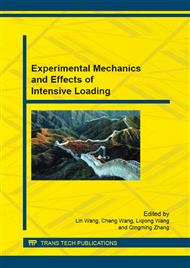p.170
p.177
p.183
p.197
p.204
p.210
p.219
p.227
p.237
The Tensile Properties of PVB at Intermediate Strain Rate Using the In Situ Hopkinson Bar
Abstract:
Polyvinyl butyral (or PVB) is commonly used as interlayer in architectural laminated glass and windshield in automobiles for its strong binding, optical clarity, adhesion to many surfaces, toughness and flexibility. A modified in-situ Hopkinson bar system is used to measure the tensile properties of the PVB with the strain rates of 30~100 s-1. In this system, a high impedance striker tube with the rubber pulse shaper is use to generate a long loading pulse of 50ms. Two X-cut quartz piezoelectric force transducers are sandwiched between the specimen and two bars respectively to directly measure the dynamic loading forces, and the strain field of the specimen is calculated by the Digital Image Correlation (DIC) method via photos obtained by the high speed camera. The local deformation of the full-field specimen was clearly displayed and the fracture strain of the specimen was evaluated. The results show that the tensile strengths of the PVB increase with increasing loading strain rates.
Info:
Periodical:
Pages:
204-209
Citation:
Online since:
August 2015
Keywords:
Price:
Сopyright:
© 2015 Trans Tech Publications Ltd. All Rights Reserved
Share:
Citation:


